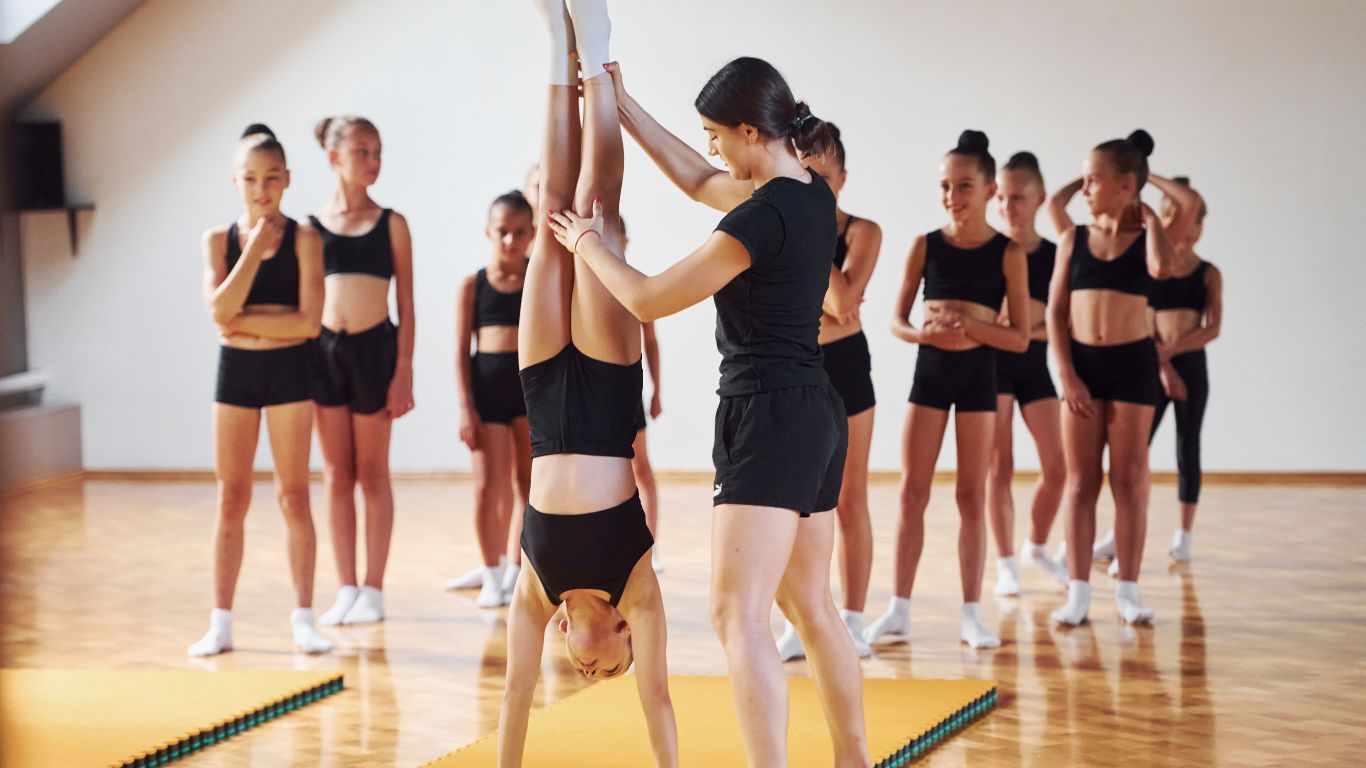Gymnastic mats provide safety and comfort for athletes. They are essential for training and competitions.
Designed to cushion falls and reduce impact, gymnastic mats are a crucial component in any gymnast’s equipment arsenal. These mats vary in thickness, size, and material, catering to different levels of skill and types of gymnastics. Quality mats offer durable, high-density foam that absorbs shocks effectively, safeguarding practitioners during routines and skills development.
The right mat can significantly decrease the risk of injuries, making them indispensable for beginners and professionals alike. Whether used in schools, gymnastics clubs, or home gyms, they are a foundational tool that supports athletes as they master their craft. Their versatility also extends to other sports and fitness activities that require protective flooring, exemplifying their importance in a wide array of athletic environments.
The Role Of Gymnastic Mats
In the world of gymnastics, safety is paramount. One essential piece of equipment which contributes vastly to safety is the gymnastic mat. This supplementary equipment plays two fundamental roles in gymnastics, which we will discuss in detail. These roles include cushioning impacts and preventing injuries.
Cushioning Impacts
Gymnastic mats serve a vital purpose in gymnastics by cushioning impacts. These impacts occur when gymnasts fall or land from their routines. The mats absorb the shock, providing a safe landing surface.
- Thickness: A thicker mat provides more cushion. Common thicknesses range from 1 to 2 inches.
- Material: Most gymnastic mats use polyethylene or polyurethane foam. Both materials offer excellent shock absorption.
- Size: A larger mat gives a broader landing area, reducing the chance of missed landings.
Preventing Injuries
Preventing injuries is another major role of gymnastic mats. They help reduce the risk of serious harm to gymnasts.
- Slip-Resistant Surface: Mats often have a non-slip surface. This helps prevent accidental slips or falls.
- Soft Landing: Mats ensure a soft landing, reducing the force exerted on the body, particularly on joints and muscles.
- Boundary Lines: Many mats have boundary lines for gymnasts to follow, which can help avoid collisions.
Remember, gymnastic mats are not just for comfort; they play a crucial role in safety, ensuring every tumble and lift doesn’t turn into a potential injury. Choosing the right mat can make training safer and more effective.
Types Of Gymnastics Mats
Explore the fascinating world of gymnastics mats! Perfect for your safety and talent, these mats come in different types. Here’s a simple guide to help you choose the right one for your needs.
Panel Mats
Panel mats, one of the traditional types of gymnastic mats, feature firm foams with durable covers. The amazing facets of these mats include:
- Durability: Ensures long-lasting use due to its superior quality.
- Versatility: Perfect for different gymnastic exercises.
- Portable: Can be folded for easy storage and transportation.
Crash Mats
Crash mats excel in providing extra cushion to prevent injuries. Here are some noteworthy attributes:
- Safety over Shock: These mats absorb shocks, ensuring optimum safety conditions.
- Extra Comfort: Thick cushion layer gives you a soft landing.
Flexi-rolls
Flexi-Rolls are perfect for gyms with limited space. The standout features include:
| Easy to Roll: | Flexi-Rolls can be rolled up and stored effortlessly to save space. |
| Compact: | The design is compact but still spacious enough for various gymnastic activities. |
Choosing the right gymnastics mat plays a huge role in a gymnast’s safety and performance. Prioritize your needs when exploring the different types of mats. A good mat is a crucial step to becoming a phenomenal gymnast!
Materials And Manufacturing
The right gymnastic mat combines safety, comfort, and durability. Manufacturers focus on high-quality materials to ensure the mats can withstand rigorous gymnastics routines. From the inner foam to the outer cover, every element undergoes careful selection. This ensures gymnasts can perform their best, with optimal support and minimal risk of injury.
Foam Density And Thickness
Two critical factors in gymnastics mats are foam density and thickness. High-density foam provides firm support for high-impact routines. Thicker foam mats cushion the body during floor exercises.
- Low-density foam is softer, for low-impact activities.
- High-density foam supports tumbling and jumping.
Thickness varies:
| Use | Thickness |
|---|---|
| Light Training | 1-2 inches |
| Competitive Training | 2-3 inches |
| Professional Use | 3+ inches |
Vinyl Covers And Durability
The outer covering of a gymnastic mat must be tough. Vinyl covers are popular for their resilience. They resist tears, punctures, and moisture. The durability of these covers ensures a long mat lifespan even with daily use.
- Durable vinyl withstands rough landings.
- Easy to clean surfaces keep mats hygienic.
- Non-slip textures enhance safety.
Selecting The Right Mat For Your Needs
Choosing the perfect gymnastic mat can be a game changer. A good mat supports skills and prevents injuries. Consider mat type, size, material, and thickness. Let’s dive into how to pick the right mat for your gymnastics journey.
Skill Level Considerations
Athletes need mats that match their skill level. Beginners require thick, soft mats for protection. Advanced gymnasts look for firmer options to perfect their technique. Check the table below:
| Skill Level | Mat Thickness | Mat Firmness |
|---|---|---|
| Beginner | 2-4 inches | Soft |
| Intermediate | 1.5-2.5 inches | Medium |
| Advanced | 1.5 inches | Firm |
Space And Portability Requirements
Space at home or in a gym guides your choice too. Think about mat size and storage. Foldable mats offer easy storage and transport. See the bullet points for space-saving tips:
- Measure your space before buying.
- Choose mats that fold or roll easily.
- Look for mats with carrying handles.
- Select lightweight materials for kids to move.
Maintenance And Care
Keeping gymnastic mats clean and well-stored enriches their lifespan and safety. Explore basic rules of maintaining gymnastic mats in perfect shape.
Mat cleanliness is vital to maintain its quality and appearance.
- Wipe the mat with a mild soap solution every week.
- Rinse off the soap with a wet cloth.
- Avoid harsh chemicals. They might harm the mat’s material.
- Always dry the mat properly before storing it.
Proper mat storage enhances its durability and efficiency.
- Store each mat in cool, dry places.
- Avoid folding the mats. It might cause creases.
- Use a mat storage rack for best results.
- Keep mats away from sharp objects to prevent damage.
Investing In Safety
Investing in a safe environment plays a crucial role in your gymnastics journey. It starts with the right mat. Let’s delve deeper into the importance of choosing a quality mat for safety.
Cost Vs. Safety
Saving money on a mat may seem tempting. Yet, the primary concern should always be safety. Cheaper mats tend to provide less protection and wear out quickly.
A premium mat is always a worthwhile investment. It guarantees a safer and more satisfying practice. You’ll also avoid injuries that can hamper performance or lead to expensive medical bills.
Long-term Value Of A Quality Mat
Choosing a quality mat provides unmatched long-term value. Here’s why:
- Durability: High-grade mats last longer, reducing the need for frequent replacements.
- Enhanced Safety: Quality mats absorb shocks better, decreasing the risk of injury.
- Comfort: Better materials make workouts more comfortable, aiding in improved performance.
A high-quality gymnastics mat acts as a wise investment. Cost may be more upfront, but the long-term benefits outweigh it. Remember, safety should always be a priority when practicing gymnastics.
Frequently Asked Questions For Gymnastic Mats
What Can I Use Instead Of A Gymnastics Mat?
You can use yoga mats, exercise mats, or thick blankets as alternatives to gymnastics mats. Interlocking foam tiles also provide cushioning for practice.
Why Are Tumbling Mats So Expensive?
Tumbling mats are pricey due to their high-quality materials and construction designed for safety and durability in rigorous gymnastics use. Their specialized manufacturing process also contributes to the higher cost.
How Thick Should A Tumbling Mat Be?
The ideal thickness for a tumbling mat is around 1. 5 to 2 inches. This provides ample cushioning and reduces injury risk during gymnastic practices. Thicker mats can enhance safety for higher intensity exercises.
Are Air Tumbling Mats Worth It?
Yes, air tumbling mats are worth it. They provide safe, compact, and portable training options. Ideal for gymnastics, martial arts, or fitness exercises. They also help to minimize injury risks.
Conclusion
With unmatched comfort, flexibility, and protection, gymnastic mats are indeed essential for any fitness enthusiast or professional athlete. There’s no denying these mats’ importance when it comes to preventing injuries and enhancing performance. So, invest wisely in your health and fitness with superior quality gymnastic mats.
Optimize your workout experience today with the right mat that suits your personal style and needs.









